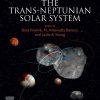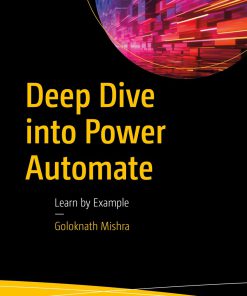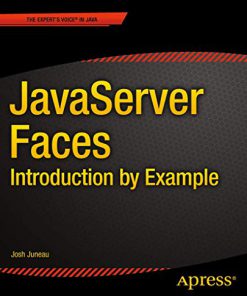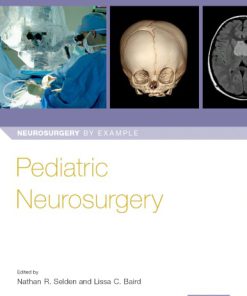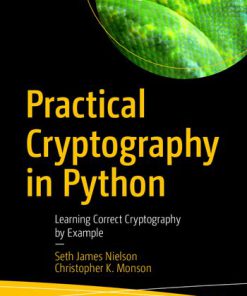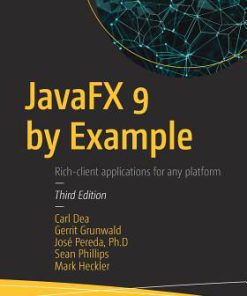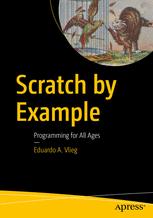Plasma Simulations by Example 1st Edition by Lubos Brieda 0429801051 9780429801051
$50.00 Original price was: $50.00.$25.00Current price is: $25.00.
Plasma Simulations by Example 1st Edition by Lubos Brieda – Ebook PDF Instant Download/DeliveryISBN: 0429801051, 9780429801051
Full download Plasma Simulations by Example 1st Edition after payment.
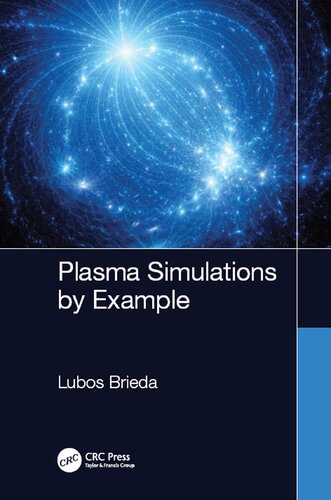
Product details:
ISBN-10 : 0429801051
ISBN-13 : 9780429801051
Author: Lubos Brieda
The study of plasmas is crucial in improving our understanding of the universe, and they are being increasingly utilised in key technologies such as spacecraft thrusters, plasma medicine, and fusion energy. Providing readers with an easy to follow set of examples that clearly illustrate how simulation codes are written, this book guides readers through how to develop C++ computer codes for simulating plasmas primarily with the kinetic Particle in Cell (PIC) method. This text will be invaluable to advanced undergraduates and graduate students in physics and engineering looking to learn how to put the theory to the test. Features: Provides a step-by-step introduction to plasma simulations with easy to follow examples Discusses the electrostatic and electromagnetic Particle in Cell (PIC) method on structured and unstructured meshes, magnetohydrodynamics (MHD), and Vlasov solvers Covered topics include Direct Simulation Monte Carlo (DSMC) collisions, surface interactions, axisymmetry, and parallelization strategies. A video of the author discussinf the book can be accessed here: https://www.youtube.com/watch?v=HIlzx0DXIes
Plasma Simulations by Example 1st Table of contents:
CHAPTER 1 ■ Fundamentals
1.1 INTRODUCTION
1.2 GAS SIMULATION APPROACHES
1.2.1 Direct Method
1.2.2 Boltzmann Equation
1.2.3 Maxwell-Boltzmann Distribution Function
1.2.4 Fluid and Kinetic Methods
1.2.5 Lagrangian and Eulerian Descriptions
1.2.6 Comparison of Fluid and Kinetic Approaches
1.3 ELECTROSTATIC PARTICLE IN CELL METHOD
1.3.1 Lorentz Force
1.3.2 Maxwell’s Equations
1.3.3 Poisson’s Equation
1.3.4 Simulation Main Loop
1.4 SINGLE PARTICLE MOTION
1.4.1 Domain Discretization
1.4.2 Finite Difference Method
1.4.3 Potential Solver
1.4.3.1 Tridiagonal Algorithm
1.4.3.2 Jacobi Iteration
1.4.3.3 Gauss-Seidel Scheme
1.4.3.4 Successive Over Relaxation
1.4.3.5 Convergence Check
1.4.4 Electric Field
1.4.5 Particle Motion
1.4.5.1 Forward Euler Method
1.4.5.2 Backward Euler
1.4.5.3 Leapfrog Method
1.4.5.4 Alternative Approaches
1.4.6 Interpolation
1.4.7 Diagnostics
1.5 SUMMARY
CHAPTER 2 ■ Grounded Box
2.1 INTRODUCTION
2.2 SIMULATION SETUP
2.2.1 Pseudocode
2.3 WORLD OBJECT
2.3.1 Constructor
2.3.2 Declaration and Implementation
2.3.3 Multiple Files
2.3.4 Header Guards
2.3.5 Implementation
2.3.6 Mesh Resolution
2.4 FIELD OBJECT
2.4.1 Memory Allocation
2.4.2 Operator Overloading
2.4.3 Templates
2.4.4 Move and Copy Constructors
2.4.5 Additional Operators
2.4.6 Output
2.4.7 Three-Component Vectors
2.4.8 Adding Fields to World
2.4.9 Initial Output
2.4.10 Visualization
2.5 POTENTIAL SOLVER
2.6 ELECTRIC FIELD
2.7 PARTICLES
2.7.1 Particle Loading
2.7.2 Random Numbers
2.7.3 Node Volumes
2.7.4 Scatter: Particle to Mesh Interpolation
2.7.5 Number Density
2.8 CHARGE DENSITY
2.8.1 Numerical Noise
2.8.2 Quiet Start
2.9 PARTICLE PUSH
2.9.1 Gather: Mesh to Particle Interpolation
2.9.2 Velocity and Position Update
2.9.3 Particle Boundary Check
2.9.4 Velocity Rewind
2.9.5 Time Step
2.10 DIAGNOSTICS
2.10.1 Elapsed Time
2.10.2 Particle Counts, Momentum, and Energy
2.10.3 Animation
2.11 MAIN LOOP
2.12 RESULTS
2.12.1 Convergence Check
2.13 SUMMARY
CHAPTER 3 ■ Flow Around a Sphere
3.1 INTRODUCTION
3.2 SIMULATION DOMAIN
3.3 POTENTIAL SOLVER
3.3.1 Sugarcubing
3.3.2 Neumann Boundaries
3.3.3 Boltzmann Electron Model
3.3.4 Non-Linear Poisson Solver
3.4 PARTICLE INJECTION AND REMOVAL
3.4.1 Cold Beam Source
3.4.2 Particle Removal
3.4.3 Alternate Storage Schemes
3.5 STEADY STATE AND DATA AVERAGING
3.6 POTENTIAL SOLVER REVISITED
3.6.1 Matrix Representation
3.6.2 Sparse Matrix
3.6.3 Preconditioned Conjugate Gradient Solver
3.6.4 Newton-Raphson Linearization
3.6.5 Quasi-Neutral Approximation
3.7 SUMMARY
CHAPTER 4 ■ Material Interactions
4.1 INTRODUCTION
4.2 MULTIPLE SPECIES
4.3 SURFACE INTERACTIONS
4.3.1 Rebound Algorithm
4.3.2 Diffuse Reflection
4.3.3 Reflection Velocity
4.3.4 Species Change
4.3.5 Sputtering and Surface Emission
4.4 WARM BEAM
4.4.1 Velocity Sampling
4.4.2 Particle Merge
4.5 DIAGNOSTICS
4.5.1 Macroscopic Properties
4.5.2 Macroparticle Count
4.5.3 Particle Plots
4.6 COLLISIONS
4.6.1 Collision Cross Section
4.6.2 Collision Modeling
4.6.3 Chemistry
4.6.4 Monte Carlo Collisions (MCC)
4.7 DSMC
4.7.1 Particle Sorting
4.7.2 Collision Groups
4.7.3 Collision Probability
4.7.4 Momentum Exchange Collision Handler
4.8 SUBCYCLING
4.9 DIELECTRIC BOUNDARIES
4.10 DISCRETIZED SURFACES
4.10.1 Line Triangle Intersection
4.10.2 Particle Impacts
4.10.3 Caveats
4.11 SUMMARY
CHAPTER 5 ■ Symmetry
5.1 INTRODUCTION
5.2 SYMMETRY
5.2.1 Domain Boundary Condition
5.2.2 Particles
5.2.3 Results
5.3 PERIODIC SYSTEMS
5.3.1 Domain Boundary
5.3.2 Particles
5.3.3 Density Synchronization
5.3.4 Results
5.4 TWO-DIMENSIONAL CODES
5.5 PLANAR (XY) CODES
5.5.1 Node Volumes
5.5.2 Data Containers
5.5.3 Scatter and Gather
5.5.4 Output
5.6 AXISYMMETRIC (RZ) CODES
5.6.1 Node Volumes
5.6.2 Finite Volume Method
5.6.3 Particle Source
5.6.4 Scatter and Gather
5.6.5 Particle Rotation
5.6.6 Results
5.7 SUMMARY
CHAPTER 6 ■ Unstructured Meshes
6.1 INTRODUCTION
6.2 MESH GEOMETRY
6.2.1 Mesh Generation
6.2.2 Mesh Formats
6.2.3 Mesh Import
6.2.4 Cell Volumes
6.2.5 Field Object
6.2.6 Node Volumes
6.2.7 Output
6.3 PARTICLE INJECTION
6.4 MESH INTERPOLATION
6.4.1 Shape Factors
6.4.2 Cell Search
6.4.3 Cell Neighbors
6.4.4 Scatter and Gather
6.5 PARTICLE MOTION
6.5.1 Number Density
6.5.2 Neutral Results
6.6 FINITE ELEMENT METHOD
6.6.1 Strong Form
6.6.2 Weak Form
6.6.3 Galerkin Form
6.6.4 Formulation with Shape Functions
6.6.5 Matrix Form
6.6.6 Element View
6.6.7 Matrix Assembly
6.6.8 Quadrature
6.6.9 Shape Functions
6.6.10 Coordinate Transformation
6.6.11 Single Element Algorithm
6.6.12 Derivatives
6.6.13 Tetrahedral Element
6.7 PUTTING IT ALL TOGETHER
6.7.1 Initialization
6.7.2 Matrix Assembly
6.7.3 Shape Function Derivatives
6.7.4 Nonlinear Solver
6.7.5 Solution Assembly
6.7.6 Electric Field
6.7.7 Results
6.8 SUMMARY
CHAPTER 7 ■ Electromagnetics
7.1 INTRODUCTION
7.2 CLASSIFICATION
7.3 MAGNETIZATION
7.3.1 Boris Push
7.4 MAGNETOSTATICS
7.4.1 Vector Potential
7.4.2 Scalar Potential
7.4.3 Magnetized Sphere
7.5 ELECTROMAGNETIC PIC
7.5.1 Curl
7.5.2 Staggered Grid
7.5.3 Time Integration
7.5.4 Boundary Conditions
7.5.5 Gauss’ Law
7.5.6 Putting It All Together
7.5.7 Approximations
7.5.8 Relativistic Push
7.5.9 Example
7.6 SUMMARY
CHAPTER 8 ■ Eulerian Methods
8.1 INTRODUCTION
8.2 MAGNETOHYDRODYNAMICS
8.2.1 Conservation Equations
8.2.2 Single Fluid MHD Equations
8.3 ADVECTION-DIFFUSION EQUATION
8.3.1 Steady State Form
8.3.2 Unsteady Problem
8.3.3 Stability Analysis
8.3.4 Alternative Time Integration Methods
8.3.5 Example
8.4 ELECTRON MODELS
8.4.1 Polytropic Relationship
8.4.2 Detailed Electron Model
8.5 VLASOV SOLVERS
8.5.1 Two-Stream Instability Example
8.6 SUMMARY
CHAPTER 9 ■ Parallel Programming
9.1 INTRODUCTION
9.2 ARCHITECTURES
9.2.1 Multithreading
9.2.2 MPI
9.2.3 CUDA
9.3 CAVEATS
9.3.1 Race Condition
9.3.2 Locks
9.3.3 Deadlock
9.3.4 Overhead
9.4 PROFILING
9.5 PARALLELIZATION STRATEGIES
9.5.1 Domain Decomposition
9.5.2 Ensemble Averaging
9.5.3 GPU Concurrent Computing
9.6 EXAMPLES
9.6.1 Multithreaded Particle Push
9.6.1.1 Number of Threads
9.6.1.2 Density Calculation
9.6.1.3 Parallel Efficiency
9.6.2 MPI Domain Decomposition
9.6.2.1 Subdomains
9.6.2.2 Particle Transfer
9.6.2.3 Boundary Update
9.6.2.4 Potential Solve
9.6.3 CUDA Potential Solve
9.7 SUMMARY
People also search for Plasma Simulations by Example 1st:
plasma simulations by example pdf
plasma simulations by example github
plasma physics simulations
plasma physics via computer simulations
multi scale simulations of plasma with ipic3d
Tags: Plasma Simulations, Example, Lubos Brieda, technologies
You may also like…
Computers - Programming
Writing Great Specifications: Using Specification by Example and Gherkin 1st Edition Kamil Nicieja
Computers - Programming
Medicine
Pediatric Neurosurgery 1st Edition by Dr Nathan Selden,Dr Lissa Baird ISBN 0190617071 978-0190617073
Computers - Computer Certification & Training
Computers - Hardware
Computers - Networking
Scratch by Example Programming for All Ages 1st Edition Eduardo A. Vlieg
Computers - Web Development



